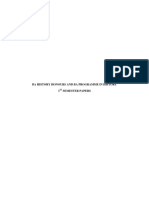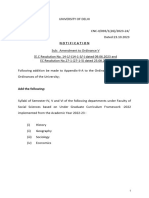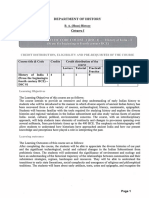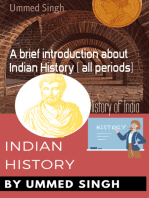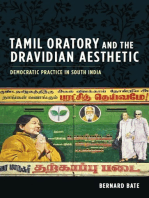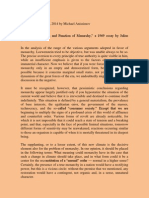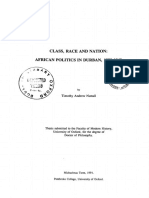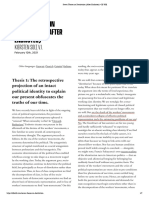139 | Page
DEPARTMENT OF HISTORY Category I BA (Hons.) History
CREDIT DISTRIBUTION, ELIGIBILITY AND PRE-REQUISITES OF THE COURSE
Course title & Code Credits Credit distribution of the course Eligibility criteria Pre-requisite of the course (if any) Lecture Tutorial Practical/ Practice History of India – II c.300 CE - 750 CE DSC 1 4 3 1 0 12
th
Pass Should have studied History of India -I (From the beginning to fourth century BCE
)
Learning Objectives
The Learning Objectives of this course are as follows: This course is about the early historical and the early medieval periods of Indian history. It explores the transition from the early historical to the early medieval phase highlighting major changes that shaped the character of Indian civilization. The course tries to delineate the important developments in the arena of economy, society, religion and culture. The purpose of this course is to familiarise students with the ways in which historians work with sources of various kinds and reconstruct our past.
Learning outcomes
After completing this course, the students will be able to
•
Discuss the ways in which historians have questioned the characterization of the Mauryan state.
•
Delineate changes in agriculture, technology, craft-production, urban development, trade and use of currency.
•
Analyse critically the changes in the varna/caste systems and the changing nature of gen-der relations and property rights.
•
Write and undertake projects related to religious developments, art, architecture, and forms of patronage.
SYLLABUS OF DSC-1 Unit I:
Development of Political Structures (c. 4th century BCE to c. 300 CE) (12 Hours) 1.
The Mauryan empire; the nature of dhamma 2.
Post-Mauryan polities with special reference to the Kushanas and the Satavahanas 3.
Tamilakam
DISCIPLINE SPECIFIC CORE COURSE -1 (DSC-1) – : History of India – II: c.300 to 750 CE

140 | Page
Unit II:
Economy and society (c. 4th century BCE to c. 300 CE) (16 Hours) 1.
Expansion of agrarian economy and production relations 2.
Urban growth: north India, central India, the Deccan and south India; craft production; trade interactions across the Indian sub-continent and beyond 3.
Social stratification: varna; jati; untouchability; gender; marriage and property relations
Unit III:
Polity, Economy and Society (c. 4th century to 750 CE) (16 Hours) 1.
The nature of polities 2.
Agrarian developments, land grants and peasantry 3.
Urban patterns; trade and currency 4.
Society: the proliferation of jatis: changing norms of marriage and inheritance
Unit IV:
Religion and Cultural developments (c. 4th century BCE – 750 CE) (16 Hours) 1.
Theistic Traditions 2.
Art and architecture; forms of patronage (Sculptures, Stupas, Rock Cut Caves, and Temples)
Practical component (if any) - NIL Essential/recommended readings Unit I.
This unit would enable students to trace the history of changing political developments from the Mauryan to post-Mauryan states.
●
Allchin, F. R. (et al.) (1995). The Archaeology of Early Historic South Asia: The Emergence of Cities and States. Cambridge: Cambridge University Press. (Chapter 10).
●
Karashima, N. (ed.) (2000). A Concise History of South India: Issues and Interpretations. New Delhi: Oxford University Press. (Chapter 2).
●
Patrick Olivelle. (2012). ‘Asoka's Inscriptions as Text and Ideology’ by in Reimagining Asoka Memory and History, (ed.) Patrick Olivelle, Janice Leoshko, and Himanshu Prabha Ray, pp. 158-183.
●
Sharma, R.S. (1996). Aspects of Political Ideas and Institutions in Ancient India. Delhi: Motilal Banarsidas. (Chapters XVIII, XIX, XXIII) (Also available in Hindi).
●
Singh, Upinder. (2008). A History of Ancient and Early Medieval India: From the Stone Age to the 12th Century. Delhi: Pearson Longman. (Chapters 6, 7 and 8) (Also available in Hindi).
●
Thapar, Romila. (2012). Asoka and the Decline of the Mauryas. Delhi: Oxford University Press. (Also available in Hindi).
●
Early India: From the Origins to AD 1300. Delhi: Penguin. (Also available in Hindi).
Unit II.
This unit will apprise students of the socio-economic developments with particular attention to agrarian relations and production as well as varna, jati, gender relations.
●
Chakravarti, Ranabir. (2016). Exploring Early India up to c. AD 1300, Delhi: Primus, 3rd edition. (Chapter 5). (Also available in Hindi).
●
Chakravarti, Uma. (2018). Gendering Caste: Through a Feminist Lens, SAGE Publications Pvt Ltd, 1st edition, (Chapter 3 and 4).
●
Champakalakshmi, R. (1996). Trade, Ideology and Urbanization: South India 300BC to Ad 1300. Delhi: Oxford University Press, pp 14-36.
●
Jaiswal, Suvira. (1998). Caste: Origin, Function and Dimensions of Change, Delhi: Manohar. (Chapter 2.) (Also available in Hindi).
●
Jha. Vivekanand. (1997). Caste, ‘Untouchability and Social Justice: Early North Indi-an Perspective’. Social Scientist, 25, pp. 19-30.
●
Ray, H.P. (1986). Monastery and Guild: Commerce under the Satavahanas. Delhi: Ox-ford University Press.
141 | Page
●
Sahu, B. P. (ed). (1997). Land system and Rural society in Early India, Delhi: Manohar. (Introduction.).
●
Shah, Shalini (2012). The Making of Womanhood: Gender Relations in The Mahabharata, Delhi: Manohar. (Chapters 2 and 4). (Also available in Hindi,
●
Granthshilpi, 2016).
●
Singh, Upinder. (2008). A History of Ancient and Early Medieval India: From the Stone Age to the 12th Century. Delhi: Pearson Longman. (Chapters 6 and 8). (Also available in Hindi).
Unit III.
This unit introduces students to the varied perspectives with regard to the nature of polities, agrarian expansion as well as social and urban processes.
●
Chakravarti, Ranabir. (2016). Exploring Early India up to c. AD 1300, Delhi: Primus, 3rd edition. (Chapter 6 and 7). (Also available in Hindi).
●
Chattopadhyaya, B. D. (1994). The Making of Early Medieval India. Delhi: Ox-ford University Press. (Introduction.)
●
Roy, Kumkum. (2010). ‘Gender Relations during the First Millennium, An Overview’, in The Power of Gender & the Gender of Power: Explorations in
●
Early Indian History. Delhi: Oxford University Press. (Chapter 10).
●
Sharma, R. S. (1990). Sudras in Ancient India: A Social History of the Lower
●
Order Down to circa. A. D. 600. Delhi: Motilal Banarsidas. (Chapters 7 and 8.)
●
(Also available in Hindi).
●
(1980). Indian Feudalism. Madras: Macmillan. (Chapter 1.) (Also available in Hindi).
●
Singh, Upinder. (2008). A History of Ancient and Early Medieval India: From the Stone Age to the 12th Century. Delhi: Pearson Longman. (Chapters 9 and 10.) (Also available in Hindi).
Unit IV.
This unit traces the religious and cultural developments in the period of study with regard to Puranic Hinduism. It also aims at familiarising students with developments in the fields of art, architecture and changing forms of patronage.
●
Brockington, J.L. (1997). The Sacred Thread: A Short History of Hinduism. Delhi: Ox-ford University Press, 2nd edition.
●
Huntington, S. (1985). The Art of Ancient India: Buddhist, Hindu, Jain. New Delhi: Weather Hill.
●
Miller, B.S. (1992). The Powers of Art: Patronage in Indian Culture. Delhi: Ox-ford University Press.
●
Nath, Vijay, (2001). ‘From 'Brahmanism' to 'Hinduism': Negotiating the Myth of the Great Tradition’, Social Scientist, Vol. 29, pp. 19-50.
●
Shrimali, K. M. (2017). Prachin Bhartiya Dharmon ka Itihas. Delhi: Granth Shilpi.
●
Singh, Upinder. (2008). A History of Ancient and Early Medieval India: From the Stone Age to the 12th Century. Delhi: Pearson Longman. (Chapters 7, 8, 9 & 10) (Also available in Hindi).
Suggestive readings
●
Agrawal, V.S. (2004). Studies in Indian Art, Varanasi: Vishwavidyalaya Prakashan.
●
Alcock, Susan E. (et. al.) (2001). Empires: Perspectives from Archaeology and History, Cambridge: Cambridge University Press. (Chapter 6, pp. 155- 178).
●
Basham, A.L. (1954). The Wonder that was India: A survey of the history and culture of the Indian subcontinent before the coming of the Muslims. Calcutta: Rupa.
142 | Page
●
Bhattacharji, Sukumari. (1970). The Indian Theogony, Cambridge University Press.
●
Chakrabarti, Kunal. (2001) Religious Process: The Puranas and the Making of a Region-al Tradition. New Delhi: Oxford University Press.
●
Chakrabarti, Kunal & Sinha, Kanad. (2019). State, Power and Legitimacy the Gup-ta Kingdom, New Delhi: Primus.
●
Chattopadhyaya, B.D. (2003). Studying Early India: Archaeology, Texts, and Historical Issues. Delhi: Permanent Black. (Chapter 3.)
●
Desai, D. (2013). Art and Icon: Essays on Early Indian Art. Delhi: Aryan Books Inter-national.
●
Dehejia, V. (2005). Discourse In Early Buddhist Art: Visual Narratives of India, New Delhi: Munshiram Manoharlal Publishers Pvt. Ltd. 5th edition.
●
Dhar, Parul P. (ed.). (2006). Indian Art: Changing Perspectives. Delhi: D. K. Printworld P Ltd. and National Museum. (Introduction).
●
Flood, Gavin. (2003). The Blackwell Companion to Hinduism, Blackwell Publishing Ltd.
●
Gethin, Rupert. (1998). The Foundations of Buddhism. Oxford: Oxford University Press.
●
Gurukkal, Rajan. (2010). Social Formations of Early South India. Delhi: Oxford University Press. (Chapters 6 and 7).
●
Gupta, S.P. and Asthana, Shashi Prabha. (2004). Elements of Indian art, Delhi: DK Printworld, 2nd edition. (Chapter 1 and 2).
●
Habib, Irfan and Faiz Habib. (2012). Atlas of Ancient Indian History. Delhi: Ox-ford University Press.
●
Harle, J. C. (1986). The Art and Architecture of the Indian Subcontinent, New York: Viking Penguin.
●
Jaini, P. (1979). The Jaina Path of Purification. Berkeley: University of California Press.
●
Jaiswal, Suvira. (1981). The Origin and Development of Vaisnavism: Vaisnavism from 200 BC to AD 500. Delhi: Munshiram Manoharlal Publishers Pvt. Ltd. (Chapters 3, 6 7, and Conclusion) (Also available in Hindi).
●
Jha, D.N. (2020). Ancient India in Historical Outline, 4th Revised Edition, New Delhi: Manohar Publishers & Distributors. (Chapter 7 and 8.) (Also available in Hindi).
●
Jha, D.N. (ed.) (2003). The Feudal Order: State, Society and Ideology in Early Medieval India. New Delhi: Manohar Publishers and Distributors.
●
Kosambi, D. D. (1956). An Introduction to the Study of Indian History. Bombay: Popular Prakashan. (Also available in Hindi).
●
Lahiri, Nayanjot. (2015). Ashoka in Ancient India. Delhi: Permanent Black.
●
Majumdar, R.C. (1970). The Classical Age. Bombay: Bharatiya Vidya Bhavan (3rd edition). (Also available in Hindi).
●
Mitter, Partha. (2011). Indian Art, Delhi: Oxford University Press.
●
Mukherjee, B.N. (1989). Rise and Fall of the Kushana Empire. Calcutta: Firma K.L. Mukhopadhyay.
●
Olivelle, P. (ed.) (2006). Between the Empires: Society in India 300 BCE to 400 CE. New York: Oxford University Press.
●
Olivelle, P., J. Leoshko and H.P. Ray. (eds.) (2012). Reimagining Asoka: Memory and History. New Delhi: Oxford University Press.
●
Pandey, G. C. (1990). Bauddha Dharma ke Vikas ka Itihas. Lucknow: Uttar Pradesh Hindi Sansthan, 3rd edition.
●
Pollock, Sheldon. (2007). The Language of the Gods in the World of Men: Sanskrit, Culture, and Power in Premodern India, Delhi: Permanent Black.








